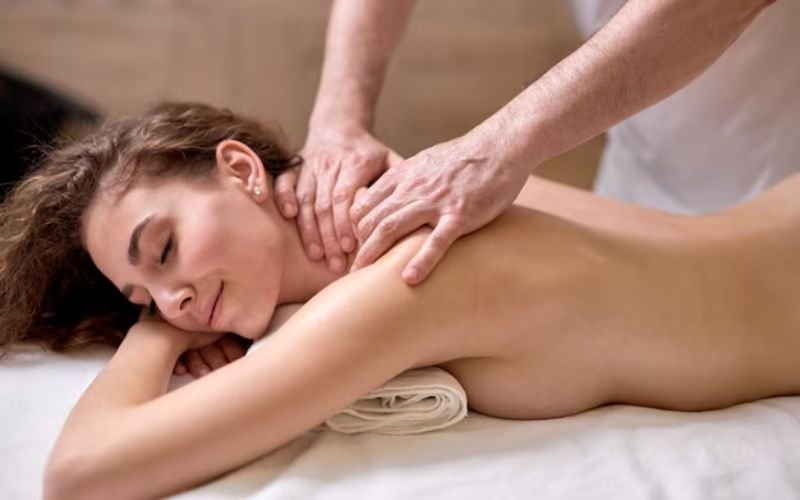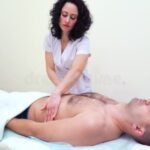In today’s fast-paced world, taking time for self-care is essential. One of the most effective ways to relax and rejuvenate both mind and body is through a full body massage. Whether you’re new to the experience or a seasoned spa-goer, understanding the benefits, techniques, and what to expect can enhance your massage experience.

What is a Full Body Massage?
A full body massage is a comprehensive therapeutic session that involves the manipulation of muscles and soft tissues across the entire body. This treatment is designed to promote relaxation, relieve muscle tension, improve circulation, and enhance overall well-being. Here’s an elaboration on what a full body massage entails:
Key Components of a Full Body Massage
- Duration:
- A typical session lasts between 60 to 90 minutes, though it can be longer depending on individual needs and preferences.
- Techniques:
- Various massage techniques are used during a full body massage, including Swedish, deep tissue, aromatherapy, hot stone, and others. Each technique has specific benefits and is chosen based on the client’s requirements.
- Areas Covered:
- Head and Scalp: Focuses on relieving tension headaches and promoting relaxation.
- Neck and Shoulders: Helps to alleviate stress and tension commonly stored in this area.
- Arms and Hands: Improves circulation and eases muscle strain.
- Back: Targets both the upper and lower back to relieve pain and stiffness.
- Abdomen: Can help with digestion and relaxation.
- Legs and Feet: Reduces muscle fatigue and improves circulation.
Benefits of a Full Body Massage
- Relieves Stress and Anxiety:
- Massage therapy can significantly reduce stress hormones and promote relaxation, contributing to improved mental health.
- Eases Muscle Tension and Pain:
- By targeting tense muscles and applying pressure, a full body massage helps to alleviate chronic pain and muscle tightness.
- Improves Circulation:
- The manipulation of soft tissues enhances blood flow, which helps deliver oxygen and nutrients to tissues and organs more effectively.
- Boosts Immune Function:
- Regular massage can enhance immune function by stimulating the lymphatic system, which plays a crucial role in defending the body against infections.
- Promotes Better Sleep:
- By reducing stress and relaxing the body, a full body massage can improve sleep quality and duration.
- Enhances Skin Health:
- Massage can improve skin tone and texture by increasing blood flow and stimulating the production of natural oils.
- Increases Flexibility and Range of Motion:
- Regular massage helps to maintain flexibility and improve the range of motion in joints.
Customization and Personalization
- Individual Needs:
- Each session can be tailored to address specific areas of concern, such as chronic back pain, sports injuries, or stress relief.
- Pressure Preferences:
- Clients can choose the level of pressure that feels comfortable, from light to deep tissue massage.
- Use of Oils and Aromatherapy:
- Essential oils can be incorporated to enhance the therapeutic effects, with different oils offering various benefits, such as lavender for relaxation or eucalyptus for invigoration.
- Communication with Therapist:
- Open communication with the massage therapist ensures that the treatment is both effective and comfortable, allowing adjustments as needed.
Preparation and Aftercare
- Before the Massage:
- It is recommended to hydrate well, avoid heavy meals, and communicate any health conditions or preferences to the therapist.
- During the Massage:
- Relaxation is key; clients should focus on breathing deeply and letting go of tension. Comfortable clothing or disrobing to a level of personal comfort is common, with proper draping provided for privacy.
- After the Massage:
- Drinking plenty of water helps to flush out toxins released during the massage. Gentle stretching and rest are also beneficial to enhance the effects of the treatment.
Benefits of a Full Body Massage
- Stress Relief:
- Reduction of Cortisol Levels: Massage therapy significantly lowers cortisol, the body’s primary stress hormone. This reduction leads to a calmer mind and a more relaxed body, helping to alleviate anxiety and promote mental well-being.
- Release of Endorphins: Massage stimulates the release of endorphins, the body’s natural “feel-good” hormones, which contribute to a sense of well-being and happiness.
- Improved Circulation:
- Enhanced Blood Flow: The rhythmic pressure applied during a massage improves blood circulation, ensuring that oxygen and essential nutrients are efficiently delivered to tissues and organs.
- Detoxification: Improved circulation helps in the removal of waste products and toxins from the body, supporting overall health and vitality.
- Pain Management:
- Chronic Pain Relief: By targeting specific muscles and areas of tension, massage can alleviate chronic pain conditions such as back pain, arthritis, and fibromyalgia.
- Muscle Relaxation: Massage therapy helps to relax tight muscles and reduce spasms, leading to pain relief and improved muscle function.
- Flexibility and Mobility:
- Increased Range of Motion: Regular massages help to loosen tight muscles and improve flexibility, enhancing the range of motion in joints.
- Prevention of Injuries: By maintaining muscle elasticity and joint flexibility, massage can help prevent injuries, especially for athletes and individuals with physically demanding lifestyles.
- Enhanced Immunity:
- Stress Reduction: Lowering stress levels through massage boosts the immune system, as chronic stress can weaken immune response.
- Lymphatic System Support: Massage stimulates the lymphatic system, aiding in the removal of toxins and supporting immune function.
- Better Sleep:
- Relaxation and Calmness: The relaxation achieved through massage often leads to improved sleep patterns. The calming effect on the nervous system helps to promote deeper and more restful sleep.
- Reduction of Insomnia Symptoms: Regular massage can help reduce symptoms of insomnia by promoting relaxation and easing anxiety, leading to better overall sleep quality.
Types of Full Body Massage
- Swedish Massage:
- Techniques: Characterized by long, sweeping strokes, kneading, and circular movements.
- Benefits: Ideal for relaxation, stress relief, and improving blood circulation. It can also help in reducing muscle tension and enhancing flexibility.
- Best For: Individuals looking for a gentle and relaxing massage experience to relieve stress and improve overall well-being.
- Deep Tissue Massage:
- Techniques: Focuses on deeper muscle layers and connective tissues. Utilizes slow, deep strokes and friction techniques.
- Benefits: Effective for chronic aches and pains, tension, and muscle injuries. It helps break down scar tissue and improve muscle function.
- Best For: People with chronic muscle pain, athletes, and those recovering from injuries or experiencing muscle stiffness.
- Aromatherapy Massage:
- Techniques: Combines gentle massage techniques with the use of essential oils. The oils are chosen based on their therapeutic properties.
- Benefits: Targets physical, mental, and emotional well-being. Depending on the essential oils used, it can be calming, energizing, or uplifting.
- Best For: Individuals looking to enhance their massage experience with the benefits of aromatherapy for relaxation, mood enhancement, and overall wellness.
- Hot Stone Massage:
- Techniques: Involves the use of heated stones placed on the body and used to massage muscles. The heat from the stones penetrates deep into the muscles.
- Benefits: Provides deep relaxation, eases muscle tension, improves blood circulation, and promotes better sleep.
- Best For: Those seeking a deeply relaxing experience, relief from muscle tension, and improved circulation.
- Shiatsu Massage:
- Techniques: A Japanese technique that uses finger pressure on specific points (acupressure) to balance the body’s energy flow (Qi).
- Benefits: Helps to reduce stress, promote relaxation, improve energy flow, and alleviate pain.
- Best For: Individuals interested in a holistic approach to balance their energy and relieve stress and tension.
- Thai Massage:
- Techniques: Combines acupressure, assisted yoga postures, and deep stretching. Performed on a mat on the floor, the therapist uses their hands, knees, legs, and feet to move the client into various positions.
- Benefits: Increases flexibility, improves range of motion, relieves muscle tension, and promotes relaxation.
- Best For: People looking for an active form of massage that involves stretching and movement to improve flexibility and relieve muscle stiffness.
What to Expect During a Full Body Massage
Before the Session:
- Consultation:
- The therapist will discuss your medical history, current health condition, and any specific areas of concern. This helps them tailor the massage to your needs and ensures safety and effectiveness.
- Preparation:
- You will be asked to undress to your comfort level and lie down on a massage table, usually covered by a sheet or towel. The therapist will provide privacy for you to disrobe and will ensure you are properly draped throughout the session for modesty and comfort.
During the Session:
- Techniques:
- The therapist will use a combination of techniques suited to your needs, such as Swedish, deep tissue, or aromatherapy massage. They will apply various pressures to different parts of the body, targeting areas of tension and promoting relaxation.
- Communication:
- It’s essential to communicate with your therapist about the pressure and any discomfort you may experience during the massage. They can adjust their techniques accordingly to ensure your comfort and maximize the benefits of the session. Don’t hesitate to speak up if something doesn’t feel right or if you have any questions.
After the Session:
- Hydration:
- Drink plenty of water after the massage to help flush out toxins released during the session. Hydration is essential for aiding the body’s natural detoxification process and preventing dehydration.
- Rest:
- Take it easy for the rest of the day to maximize the benefits of the massage. Avoid strenuous activities or stressful situations, and allow your body to fully relax and integrate the effects of the treatment.
Tips for Maximizing Your Massage Experience:
- Arrive Early:
- Give yourself time to relax before your appointment. Arriving early allows you to unwind and mentally prepare for the massage, enhancing your overall experience.
- Avoid Heavy Meals:
- Eat a light meal or snack before your session to avoid discomfort during the massage. Heavy meals can make you feel lethargic and may interfere with the relaxation process.
- Stay Hydrated:
- Drink water before and after the massage to keep your body hydrated. Hydration helps support the body’s natural healing processes and ensures optimal circulation and detoxification.
- Communicate:
- Always inform your therapist of any medical conditions, injuries, or preferences you have. Open communication ensures that the massage is tailored to your individual needs and helps you get the most out of your session.
Conclusion
A full body massage is more than just a luxury; it’s a valuable tool for maintaining physical and mental health. By understanding the different types of massages and knowing what to expect, you can make the most of your next massage experience. Whether you’re looking to relieve stress, manage pain, or simply indulge in some self-care, a full body massage can be the perfect solution. So, go ahead and book that appointment – your body and mind will thank you!
Top 20 FAQs About Full Body Massage
- What is a full body massage?
- A full body massage is a therapeutic session that involves manipulating the muscles and soft tissues of the entire body to promote relaxation and overall wellness.
- How long does a full body massage typically last?
- Full body massages usually last between 60 to 90 minutes, but the duration can vary based on individual preferences and needs.
- What are the benefits of a full body massage?
- Benefits include stress relief, improved circulation, pain management, enhanced flexibility, boosted immunity, and better sleep.
- How often should I get a full body massage?
- The frequency of massages depends on individual needs and goals. Some people benefit from weekly sessions, while others may prefer monthly appointments.
- Do I need to undress completely for a full body massage?
- You can undress to your comfort level. Most people prefer to undress completely, but you can also leave underwear on if you prefer.
- Will I be covered during the massage?
- Yes, you will be covered with a sheet or towel throughout the massage. Only the area being worked on will be uncovered.
- What should I do during the massage?
- Simply relax and enjoy the experience. You can close your eyes, focus on your breathing, or even fall asleep if you wish.
- Is a full body massage painful?
- A massage should not be painful, but there may be moments of discomfort, especially during deep tissue work. It’s important to communicate with your therapist about your comfort level.
- Can I talk during the massage?
- You can talk if you wish, but many people prefer to remain quiet to fully relax and enjoy the experience.
- Should I tip my massage therapist?
- Tipping is common in the massage industry and is appreciated but not mandatory. It’s typically around 15% to 20% of the service cost.
- Are there any medical conditions that contraindicate massage?
- Yes, certain conditions like deep vein thrombosis, severe osteoporosis, or recent injuries may contraindicate massage. Always consult with your doctor before getting a massage if you have any health concerns.
- Can pregnant women get full body massages?
- Yes, prenatal massages are specifically tailored for pregnant women and can provide relief from pregnancy-related discomforts.
- Are there different types of full body massages?
- Yes, there are various types including Swedish, deep tissue, aromatherapy, hot stone, Shiatsu, and Thai massage, each offering unique benefits.
- What should I do after a full body massage?
- Drink plenty of water to stay hydrated, avoid strenuous activities, and take some time to rest and relax.
- How can I find a reputable massage therapist?
- Ask for recommendations from friends or healthcare providers, read online reviews, and inquire about the therapist’s qualifications and experience.
- Can I get a massage if I have sensitive skin?
- Yes, but be sure to inform your therapist about any skin sensitivities or allergies so they can select appropriate oils or lotions.
- Is it normal to feel soreness after a massage?
- Yes, it’s normal to experience some soreness, especially after deep tissue work. This usually resolves within a day or two.
- Can massage help with anxiety and depression?
- Yes, massage therapy has been shown to reduce symptoms of anxiety and depression by promoting relaxation and reducing stress hormones.
- Will I feel embarrassed if I fall asleep during the massage?
- Not at all! Falling asleep during a massage is quite common and a sign that you’re fully relaxed.
- Can I request a specific gender for my massage therapist?
- Yes, most spas and massage centers will accommodate gender preferences if requested in advance.
Related posts:
 Female-to-Male Body Massage: Benefits, Techniques, and Tips
Female-to-Male Body Massage: Benefits, Techniques, and Tips
 5 Ways to Make Meditation Fun and Easy
5 Ways to Make Meditation Fun and Easy
 Secrets of Health and Beauty: A Journey with AIOTechnical
Secrets of Health and Beauty: A Journey with AIOTechnical
 Ayurvedic Medicine for Stomach Health: Natural Remedies for Digestive Wellness
Ayurvedic Medicine for Stomach Health: Natural Remedies for Digestive Wellness
 Natural Sleep: The Ayurvedic Approach
Natural Sleep: The Ayurvedic Approach
 Understanding Circadian Rhythms: How to Optimize Your Daily Cycle
Understanding Circadian Rhythms: How to Optimize Your Daily Cycle
 Brain Hemorrhage: Causes, Symptoms, Treatment, Complications, and More
Brain Hemorrhage: Causes, Symptoms, Treatment, Complications, and More
 Healthy Life WellHealthOrganic
Healthy Life WellHealthOrganic
 Sweating Profusely Could Be a Sign of a Heart Attack of our Body
Sweating Profusely Could Be a Sign of a Heart Attack of our Body






